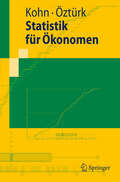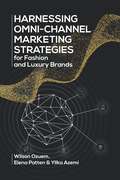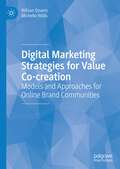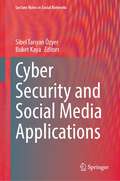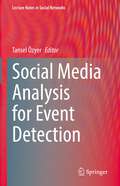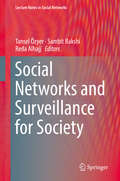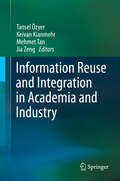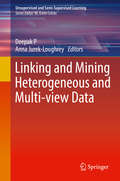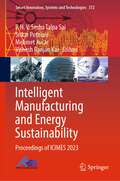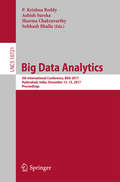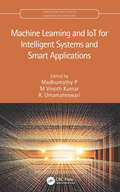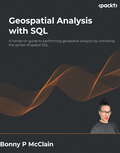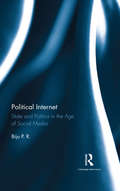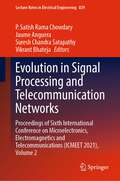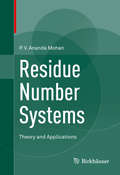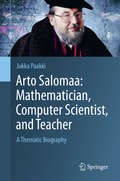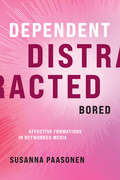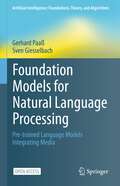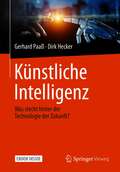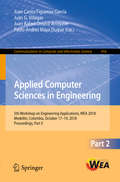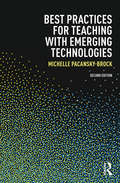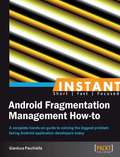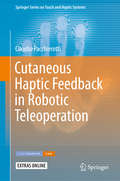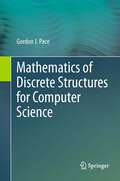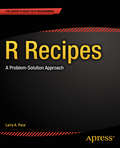- Table View
- List View
Statistik für Ökonomen
by Riza Öztürk Wolfgang KohnDie Autoren erläutern in einer anschaulichen, anwendungsorientierten und kompakten Darstellung alle elementaren statistischen Verfahren, die in der Ökonomie angewendet werden - ergänzt durch zahlreiche Beispiele und Übungen. Der Text enthält Programmanweisungen sowohl für das Statistikprogramm R (Open-Source-Progamm) als auch für SPSS. Das Buch richtet sich an Studierende, die sich in wirtschaftswissenschaftlich ausgerichteten Studiengängen mit Statistik beschäftigen.
Harnessing Omni-Channel Marketing Strategies for Fashion and Luxury Brands
by Wilson OzuemThis book provides a contemporary theoretical insight into the fashion and luxury industry, addressing potential gray areas within the literature. The authors analyze the luxury and fashion industry using multiple perspectives, allowing for a critical com
Digital Marketing Strategies for Value Co-creation: Models and Approaches for Online Brand Communities
by Wilson Ozuem Michelle WillisOnline brand communities (OBCs) are hugely important in the development of marketing strategy, but it is unclear how marketers can effectively utilise these platforms to enhance and develop consumer engagement. For an online brand community to be successful, it should allow members to feel a connection to the brand and with other members while forming a disconnection from those not belonging to the community. It should also have rituals and traditions that join members together over a revered commonality, and moral responsibility in contributing to the community. Indeed, brands play active roles in securing degrees of activity in OBCs’ through content that offers members the quality of engagement they seek. This book focuses on contemporary digital marketing issues in OBCs, offering a comprehensive examination of consumers’ response to active engagement in such communities. It discusses how brands can tap into the various levels of participation, engagement and online conversations in the development of marketing strategy and ultimately examines how an online brand community strengthens value co-creation. Balancing theory with practical approaches, this book gives serious treatment to an important yet until now overlooked area of digital marketing strategy, providing an important resource for scholars, students and practitioners.
Cyber Security and Social Media Applications (Lecture Notes in Social Networks)
by Sibel Tarıyan Özyer Buket KayaThis book offers an excellent source of knowledge for readers who are interested in keeping up with the developments in the field of cyber security and social media analysis. It covers the possibility of using augmented reality to monitor cyber security feeds in a multitasking environment. It describes a real-time scheduled security scanner. E-commerce concept labeling is tackled by introducing a lightweight global taxonomy induction system. Blogsphere analytics and online video narratives and networks are explored. The effect of global and local network structure, credibility based prevention of fake news dissemination, and detection of trending topics and influence from social media are investigated.This book helps the reader in developing their own perspective about how to deal with cyber security and how to benefit from the development in technology to tackle cyber security issues. The reader of this book will realize how to use various machine learning techniques for tackling various applications involving social medial analysis.
Social Media Analysis for Event Detection (Lecture Notes in Social Networks)
by Tansel ÖzyerThis book includes chapters which discuss effective and efficient approaches in dealing with various aspects of social media analysis by using machine learning techniques from clustering to deep learning. A variety of theoretical aspects, application domains and case studies are covered to highlight how it is affordable to maximize the benefit of various applications from postings on social media platforms. Social media platforms have significantly influenced and reshaped various social aspects. They have set new means of communication and interaction between people, turning the whole world into a small village where people with internet connect can easily communicate without feeling any barriers. This has attracted the attention of researchers who have developed techniques and tools capable of studying various aspects of posts on social media platforms with main concentration on Twitter. This book addresses challenging applications in this dynamic domain where it is not possible to continue applying conventional techniques in studying social media postings. The content of this book helps the reader in developing own perspective about how to benefit from machine learning techniques in dealing with social media postings and how social media postings may directly influence various applications.
Social Networks and Surveillance for Society (Lecture Notes In Social Networks Ser.)
by Tansel Özyer Reda Alhajj Sambit BakshiThis book focuses on recent technical advancements and state-of-the art technologies for analyzing characteristic features and probabilistic modelling of complex social networks and decentralized online network architectures. Such research results in applications related to surveillance and privacy, fraud analysis, cyber forensics, propaganda campaigns, as well as for online social networks such as Facebook. The text illustrates the benefits of using advanced social network analysis methods through application case studies based on practical test results from synthetic and real-world data. This book will appeal to researchers and students working in these areas.
Information Reuse and Integration in Academia and Industry
by Tansel Özyer Keivan Kianmehr Mehmet Tan Jia ZengThe present work covers the latest developments and discoveries related to information reuse and integration in academia and industrial settings. The need for dealing with the large volumes of data being produced and stored in the last decades and the numerous systems developed to deal with these is increasingly necessary. Not all these developments could have been achieved without the investing large amounts of resources. Over time, new data sources evolve and data integration continues to be an essential and vital requirement. Furthermore, systems and products need to be revised to adapt new technologies and needs. Instead of building these from scratch, researchers in the academia and industry have realized the benefits of reusing existing components that have been well tested. While this trend avoids reinventing the wheel, it comes at the cost of finding the optimum set of existing components to be utilized and how they should be integrated together and with the new non-existing components which are to be developed. These nontrivial tasks have led to challenging research problems in the academia and industry. These issues are addressed in this book, which is intended to be a unique resource for researchers, developers and practitioners.
Linking and Mining Heterogeneous and Multi-view Data (Unsupervised and Semi-Supervised Learning)
by Deepak P Anna Jurek-LoughreyThis book highlights research in linking and mining data from across varied data sources. The authors focus on recent advances in this burgeoning field of multi-source data fusion, with an emphasis on exploratory and unsupervised data analysis, an area of increasing significance with the pace of growth of data vastly outpacing any chance of labeling them manually. The book looks at the underlying algorithms and technologies that facilitate the area within big data analytics, it covers their applications across domains such as smarter transportation, social media, fake news detection and enterprise search among others. This book enables readers to understand a spectrum of advances in this emerging area, and it will hopefully empower them to leverage and develop methods in multi-source data fusion and analytics with applications to a variety of scenarios.Includes advances on unsupervised, semi-supervised and supervised approaches to heterogeneous data linkage and fusion; Covers use cases of analytics over multi-view and heterogeneous data from across a variety of domains such as fake news, smarter transportation and social media, among others;Provides a high-level overview of advances in this emerging field and empowers the reader to explore novel applications and methodologies that would enrich the field.
Intelligent Manufacturing and Energy Sustainability: Proceedings of ICIMES 2023 (Smart Innovation, Systems and Technologies #372)
by P. H. V. Sesha Talpa Sai Srikar Potnuru Mehmet Avcar Vishesh Ranjan KarThis book includes best selected, high-quality research papers presented at the International Conference on Intelligent Manufacturing and Energy Sustainability (ICIMES 2023) held at the Department of Mechanical Engineering, Malla Reddy College of Engineering & Technology (MRCET), Hyderabad, India, during June 23–24, 2023. It covers topics in the areas of automation, manufacturing technology, and energy sustainability and also includes original works in the intelligent systems, manufacturing, mechanical, electrical, aeronautical, materials, automobile, bioenergy, and energy sustainability.
Big Data Analytics: 5th International Conference, BDA 2017, Hyderabad, India, December 12-15, 2017, Proceedings (Lecture Notes in Computer Science #10721)
by P. Krishna Reddy, Ashish Sureka, Sharma Chakravarthy and Subhash BhallaThis book constitutes the refereed conference proceedings of the 5th International Conference on Big Data Analytics, BDA 2017, held in Hyderabad, India, in December 2017. The 21 revised full papers were carefully reviewed and selected from 80 submissions and cover topics on big data analytics, information and knowledge management, mining of massive datasets, computational modeling, data mining and analysis.
Machine Learning and IoT for Intelligent Systems and Smart Applications (Computational Intelligence in Engineering Problem Solving)
by Madhumathy P.The fusion of AI and IoT enables the systems to be predictive, prescriptive, and autonomous, and this convergence has evolved the nature of emerging applications from being assisted to augmented, and ultimately to autonomous intelligence. This book discusses algorithmic applications in the field of machine learning and IoT with pertinent applications. It further discusses challenges and future directions in the machine learning area and develops understanding of its role in technology, in terms of IoT security issues. Pertinent applications described include speech recognition, medical diagnosis, optimizations, predictions, and security aspects. Features: Focuses on algorithmic and practical parts of the artificial intelligence approaches in IoT applications. Discusses supervised and unsupervised machine learning for IoT data and devices. Presents an overview of the different algorithms related to Machine learning and IoT. Covers practical case studies on industrial and smart home automation. Includes implementation of AI from case studies in personal and industrial IoT. This book aims at Researchers and Graduate students in Computer Engineering, Networking Communications, Information Science Engineering, and Electrical Engineering.
Geospatial Analysis with SQL: A hands-on guide to performing geospatial analysis by unlocking the syntax of spatial SQL
by Bonny P McClainLeverage the power of SQL to perform geospatial analysis and increase your speed and efficiency working with a variety of spatial applications such as PostGIS and QGISKey FeaturesFollow along with actionable instructions with this practical guideBecome well-versed in advanced spatial modeling and machine learning techniquesLearn best practices for performing spatial analysis from an expert spatial data analystBook DescriptionGeospatial analysis is used in almost every industry to answer location-related questions. Combined with the power of SQL, which is becoming a popular choice for developers and analysts worldwide, this technology will help you to solve real-world spatial problems easily. This book shows you how to detect and quantify patterns in datasets through data exploration, data visualization, data engineering, and the application of analysis and spatial techniques.You'll begin by exploring the fundamentals of geospatial analysis and understand its importance along with vector and raster models, among other things. You'll then look at the framework for geospatial analysis using SQL and progress through the chapters to create a spatial database and analyze it. In the next part, you'll advance to learning about using SQL functions and building SQL queries.By the end of this book, you'll be able to make the most of open source libraries and frameworks such as PostGIS and QGIS for analyzing spatial information.What you will learnUnderstand geospatial fundamentals as a basis for learning spatial SQLGenerate point, line, and polygon data with SQLCreate geometry objects with WKT, WKB, and GeoJSONUse spatial data types to abstract and encapsulate spatial structuresWork with open source GIS combined with plug-insVisualize spatial data and expand QGIS functionality with PostgresApply location data to leverage spatial analyticsPerform single-layer and multiple-layer spatial analysesWho this book is forThis book is for anyone looking to leverage their SQL knowledge to perform geospatial analysis. GIS analysts, data analysts, and data scientists with a basic understanding of both geospatial analysis and SQL will find this book useful.
Political Internet: State and Politics in the Age of Social Media
by Biju P. R.This book investigates the Internet as a site of political contestation in the Indian context. It widens the scope of the public sphere to social media, and explores its role in shaping the resistance and protest movements on the ground. The volume also explores the role of the Internet, a global technology, in framing debates on the idea of the nation state, especially India, as well as diplomacy and international relations. It also discusses the possibility of whether Internet can be used as a tool for social justice and change, particularly by the underprivileged, to go beyond caste, class, gender and other oppressive social structures. A tract for our times, this book will interest scholars and researchers of politics, media studies, popular culture, sociology, international relations as well as the general reader.
Evolution in Signal Processing and Telecommunication Networks: Proceedings of Sixth International Conference on Microelectronics, Electromagnetics and Telecommunications (ICMEET 2021), Volume 2 (Lecture Notes in Electrical Engineering #839)
by P. Satish Rama Chowdary Jaume Anguera Suresh Chandra Satapathy Vikrant BhatejaThis book discusses the latest developments and outlines future trends in the fields of microelectronics, electromagnetics and telecommunication. It contains original research works presented at the International Conference on Microelectronics, Electromagnetics and Telecommunication (ICMEET 2021), held in Bhubaneswar, Odisha, India during 27–28 August, 2021. The papers were written by scientists, research scholars and practitioners from leading universities, engineering colleges and R&D institutes from all over the world and share the latest breakthroughs in and promising solutions to the most important issues facing today’s society.
Residue Number Systems
by P. V. Ananda MohanThis new and expanded monograph improves upon Mohan's earlier book, Residue Number Systems (Springer, 2002) with a state of the art treatment of the subject. Replete with detailed illustrations and helpful examples, this book covers a host of cutting edge topics such as the core function, the quotient function, new Chinese Remainder theorems, and large integer operations. It also features many significant applications to practical communication systems and cryptography such as FIR filters and elliptic curve cryptography. Starting with a comprehensive introduction to the basics and leading up to current research trends that are not yet widely distributed in other publications, this book will be of interest to both researchers and students alike.
Arto Salomaa: A Thematic Biography
by Jukka PaakkiThis book outlines the scientific career of Arto Salomaa, a pioneer in theoretical computer science and mathematics. The author first interviewed the subject and his family and collaborators, and he then researched this fascinating biography of an intellectual who was key in the development of these fields.Early chapters progress chronologically from Academician Salomaa's origins, childhood, and education to his professional successes in science, teaching, and publishing. His most impactful direct research efforts have been in the areas of automata and formal languages. Beyond that he has influenced many more scientists and professionals through collaborations, teaching, and books on topics such as biocomputing and cryptography. The author offers insights into Finnish history, culture, and academia, while historians of computer science will appreciate the vignettes describing some of the people who have shaped the field from the 1950s to today. The author and his subject return throughout to underlying themes such as the importance of family and the value of longstanding collegial relationships, while the work and achievements are leavened with humor and references to interests such as music, sport, and the sauna.
Dependent, Distracted, Bored: Affective Formations in Networked Media
by Susanna PaasonenA new approach to understanding the culture of ubiquitous connectivity, arguing that our dependence on networked infrastructure does not equal addiction.In this book, Susanna Paasonen takes on a dominant narrative repeated in journalistic and academic accounts for more than a decade: that we are addicted to devices, apps, and sites designed to distract us, that drive us to boredom, with detrimental effect on our capacities to focus, relate, remember, and be. Paasonen argues instead that network connectivity is a matter of infrastructure and necessary for the operations of the everyday. Dependencies on it do not equal addiction but speak to the networks within which our agency can take shape.
Foundation Models for Natural Language Processing: Pre-trained Language Models Integrating Media (Artificial Intelligence: Foundations, Theory, and Algorithms)
by Gerhard Paaß Sven GiesselbachThis open access book provides a comprehensive overview of the state of the art in research and applications of Foundation Models and is intended for readers familiar with basic Natural Language Processing (NLP) concepts. Over the recent years, a revolutionary new paradigm has been developed for training models for NLP. These models are first pre-trained on large collections of text documents to acquire general syntactic knowledge and semantic information. Then, they are fine-tuned for specific tasks, which they can often solve with superhuman accuracy. When the models are large enough, they can be instructed by prompts to solve new tasks without any fine-tuning. Moreover, they can be applied to a wide range of different media and problem domains, ranging from image and video processing to robot control learning. Because they provide a blueprint for solving many tasks in artificial intelligence, they have been called Foundation Models. After a brief introduction to basic NLP models the main pre-trained language models BERT, GPT and sequence-to-sequence transformer are described, as well as the concepts of self-attention and context-sensitive embedding. Then, different approaches to improving these models are discussed, such as expanding the pre-training criteria, increasing the length of input texts, or including extra knowledge. An overview of the best-performing models for about twenty application areas is then presented, e.g., question answering, translation, story generation, dialog systems, generating images from text, etc. For each application area, the strengths and weaknesses of current models are discussed, and an outlook on further developments is given. In addition, links are provided to freely available program code. A concluding chapter summarizes the economic opportunities, mitigation of risks, and potential developments of AI.
Künstliche Intelligenz: Was steckt hinter der Technologie der Zukunft?
by Gerhard Paaß Dirk HeckerKünstliche Intelligenz (KI) ist heute schon in unserem Alltag präsent und wird uns zukünftig in nahezu allen Lebensbereichen begegnen – von der bildgestützten Diagnose in der Medizin über das autonome Fahren und die intelligente Maschinenwartung in der Industrie bis hin zur Sprachsteuerung im smarten Zuhause. Die Potenziale der KI sind enorm, gleichzeitig kursieren viele Mythen, Ungewissheiten und Herausforderungen, die es zu meistern gilt. Dieses Buch adressiert daher die breite Öffentlichkeit – von interessierten Bürgerinnen und Bürgern bis hin zur Leitungsebene in Unternehmen, die ein besseres und tieferes technisches Verständnis von KI-Technologien aufbauen und deren Folgen abschätzen möchten.In verständlicher Sprache werden mathematische Grundlagen, Begriffe und Methoden erläutert. Eine abschließende Diskussion der Chancen und Herausforderungen hilft den Leserinnen und Lesern, die Entwicklungen zu bewerten, sie zu entmystifizieren und ihre Relevanz für die Zukunft zu erkennen.
Applied Computer Sciences in Engineering: 5th Workshop on Engineering Applications, WEA 2018, Medellín, Colombia, October 17-19, 2018, Proceedings, Part II (Communications in Computer and Information Science #916)
by Pablo Andres Maya Duque Juan Rafael Orozco-Arroyave Juan G. Villegas Juan Carlos Figueroa-GarcíaThis two-volume set (CCIS 915 and CCIS 916) constitutes the refereed proceedings of the 5th Workshop on Engineering Applications, WEA 2018, held in Medellín, Colombia, in October 2018. The 41 revised full papers presented in this volume were carefully reviewed and selected from 101 submissions. The papers are organized in topical sections such as green logistics and optimization, Internet of Things (IoT), digital signal processing (DSP), network applications, miscellaneous applications.
Best Practices for Teaching with Emerging Technologies (Best Practices in Online Teaching and Learning)
by Michelle Pacansky-BrockAs social media and Web 2.0 technologies continue to transform the learning trends and preferences of students, educators need to understand the applicability of these new tools in all types of learning environments. The second edition of Best Practices for Teaching with Emerging Technologies provides new and experienced instructors with practical examples of how low-cost and free technologies can be used to support student learning as well as best practices for integrating web-based tools into a course management system and managing student privacy in a Web 2.0 environment. "Showcase" spotlights throughout exemplify how the tools described in the book are already being used effectively in educational settings. This thoroughly revised second edition includes: a new chapter that explores how and why faculty are using the public web and open educational resources in place of a learning management system (LMS) and an expensive textbook additional tips and showcases in every chapter that illustrate faculty use of particular technologies the inclusion of new tools to replace technologies that no longer exist a revamped website featuring expanded online resources. This practical, easy-to-use guide will serve the needs of educators seeking to refresh or transform their instruction. Readers will be rewarded with an ample yet manageable collection of proven emerging technologies that can be leveraged for generating content, enhancing communications with and between students, and cultivating participatory, student-centered learning activities.
Instant Android Fragmentation Management How-to
by Gianluca PacchiellaWritten in the easy to understand Packt How-to format, this book offers the solution to the big issues in Android application development. If you want the best possible reviews for your apps, regardless of device or Android operating system, then this book is for you.
Cutaneous Haptic Feedback in Robotic Teleoperation (Springer Series on Touch and Haptic Systems #0)
by Claudio PacchierottiThis work addresses the challenge of providing effective cutaneous haptic feedback in robotic teleoperation, with the objective of achieving the highest degree of transparency whilst guaranteeing the stability of the considered systems. On the one hand, it evaluates teleoperation systems that provide only cutaneous cues to the operator, thus guaranteeing the highest degree of safety. This cutaneous-only approach shows intermediate performance between no force feedback and full haptic feedback provided by a grounded haptic interface, and it is best suitable for those scenarios where the safety of the system is paramount, e. g. , robotic surgery. On the other hand, in order to achieve a higher level of performance, this work also investigates novel robotic teleoperation systems with force reflection able to provide mixed cutaneous and kinesthetic cues to the operator. Cutaneous cues can compensate for the temporary reduction of kinesthetic feedback necessary to satisfy certain stability conditions. This state-of-the-art volume is oriented toward researchers, educators, and students who are interested in force feedback techniques for robotic teleoperation, cutaneous device design, cutaneous rendering methods and perception studies, as well as readers from different disciplines who are interested in applying cutaneous haptic technologies and methods to their field of interest.
Mathematics of Discrete Structures for Computer Science
by Gordon J. PaceMathematics plays a key role in computer science, some researchers would consider computers as nothing but the physical embodiment of mathematical systems. And whether you are designing a digital circuit, a computer program or a new programming language, you need mathematics to be able to reason about the design -- its correctness, robustness and dependability. This book covers the foundational mathematics necessary for courses in computer science. The common approach to presenting mathematical concepts and operators is to define them in terms of properties they satisfy, and then based on these definitions develop ways of computing the result of applying the operators and prove them correct. This book is mainly written for computer science students, so here the author takes a different approach: he starts by defining ways of calculating the results of applying the operators and then proves that they satisfy various properties. After justifying his underlying approach the author offers detailed chapters covering propositional logic, predicate calculus, sets, relations, discrete structures, structured types, numbers, and reasoning about programs. The book contains chapter and section summaries, detailed proofs and many end-of-section exercises -- key to the learning process. The book is suitable for undergraduate and graduate students, and although the treatment focuses on areas with frequent applications in computer science, the book is also suitable for students of mathematics and engineering.
R Recipes
by Larry A. PaceR Recipes is your handy problem-solution reference for learning and using the popular R programming language for statistics and other numerical analysis. Packed with hundreds of code and visual recipes, this book helps you to quickly learn the fundamentals and explore the frontiers of programming, analyzing and using R. R Recipes provides textual and visual recipes for easy and productive templates for use and re-use in your day-to-day R programming and data analysis practice. Whether you're in finance, cloud computing, big or small data analytics, or other applied computational and data science - R Recipes should be a staple for your code reference library.
